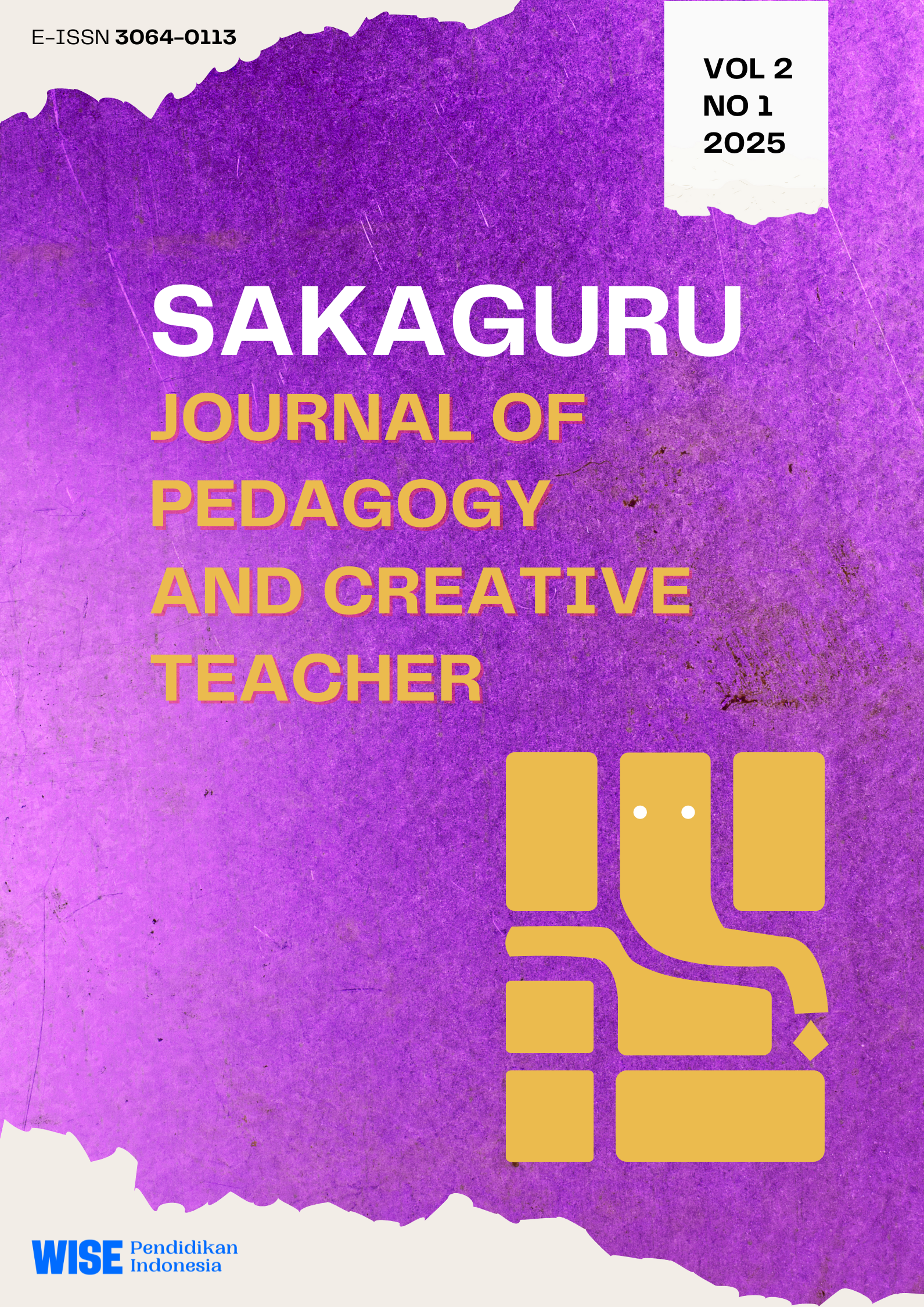Revisiting the Sustainable Development Goal 4 “Quality Education”: Insights, Prospects, and Recommendations
DOI:
https://doi.org/10.70211/sakaguru.v2i1.202Keywords:
Educational Inequality, Global Education Governance, Quality Education, Sustainable Development Goals (SDGs), SDG ImplementationAbstract
This paper explores the global challenges and prospects associated with the implementation of the United Nations Sustainable Development Goals (SDGs), with a focused analysis on Goal 4: Quality Education. Drawing on current data, scholarly research, and policy reports, the study identifies disparities in educational access and quality across regions, emphasizing how socio-economic, geographical, political, and digital divides impede equitable learning opportunities. A comparative analysis of four countries—Nigeria, India, Finland, and Japan—illustrates how varying governance structures, economic capacities, and cultural dynamics shape education outcomes. The study further examines the impact of global phenomena such as the COVID-19 pandemic, geopolitical tensions, energy transitions, and economic downturns on educational systems. Through this multi-scalar analysis, the paper identifies structural barriers and systemic weaknesses that hinder progress toward SDG 4, particularly in low-income and conflict-affected regions. The paper concludes by offering actionable recommendations, including intersectoral collaboration, inclusive education policy reforms, investment in digital infrastructure, and capacity building in under-resourced areas. The findings underscore the need for globally coordinated, locally adapted strategies that center equity and resilience to ensure the realization of inclusive and quality education for all by 2030.
References
M. Lomazzi, B. Borisch, and U. Laaser, “The Millennium Development Goals: experiences, achievements and what’s next,” Glob. Health Action, vol. 7, no. 1, p. 23695, Feb. 2014, doi: https://doi.org/10.3402/gha.v7.23695 DOI: https://doi.org/10.3402/gha.v7.23695
J. B. S. O. A. Guerra, M. Hoffmann, R. T. Bianchet, P. Medeiros, A. P. Provin, and R. Iunskovski, “Sustainable development goals and ethics: building ‘the future we want,’” Environ. Dev. Sustain., vol. 24, no. 7, pp. 9407–9428, Jul. 2022, doi: https://doi.org/10.1007/s10668-021-01831-0 DOI: https://doi.org/10.1007/s10668-021-01831-0
D. Shaw, “Women’s right to health and the Millennium Development Goals: promoting partnerships to improve access,” Int. J. Gynaecol. Obstet., vol. 94, no. 3, pp. 207–215, Sep. 2006, doi: https://doi.org/10.1016/j.ijgo.2006.04.029 DOI: https://doi.org/10.1016/j.ijgo.2006.04.029
“The 17 goals.” Accessed: Apr. 26, 2025. [Online]. Available: https://sdgs.un.org/goals
D. Le Blanc, “Towards Integration at Last? The Sustainable Development Goals as a Network of Targets,” Sustain. Dev., vol. 23, no. 3, pp. 176–187, May 2015, doi: https://doi.org/10.1002/sd.1582 DOI: https://doi.org/10.1002/sd.1582
J. Tosun and J. Leininger, “Governing the interlinkages between the Sustainable Development Goals: Approaches to attain policy integration,” Global Chall., vol. 1, no. 9, p. 1700036, Dec. 2017, doi: https://doi.org/10.1002/gch2.201700036 DOI: https://doi.org/10.1002/gch2.201700036
J. Song and C.-H. Jang, “Unpacking the sustainable development goals (SDGs) interlinkages: A semantic network analysis of the SDGs targets,” Sustain. Dev., vol. 31, no. 4, pp. 2784–2796, Aug. 2023, doi: https://doi.org/10.1002/sd.2547 DOI: https://doi.org/10.1002/sd.2547
S. Reinders, M. Dekker, and J.-B. Falisse, “Inequalities in higher education in low‐ and middle‐income countries: A scoping review of the literature,” Dev. Policy Rev., vol. 39, no. 5, pp. 865–889, Sep. 2021, doi: https://doi.org/10.1111/dpr.12535 DOI: https://doi.org/10.1111/dpr.12535
S. K. Ahmed et al., “Teacher professional development for disability inclusion in low- and middle-income Asia-Pacific countries: An evidence and gap map,” Campbell Syst. Rev., vol. 18, no. 4, p. e1287, Dec. 2022, doi: https://doi.org/10.1002/cl2.1287 DOI: https://doi.org/10.1002/cl2.1287
K. Szadkowski, “The public good and higher education in Poland,” Compare, pp. 1–19, Oct. 2021, doi: https://doi.org/10.1080/03057925.2021.1987194 DOI: https://doi.org/10.1080/03057925.2021.1987194
N. T. T. Pham, C. H. Nguyen, H. T. Pham, and H. T. T. Ta, “Internal quality assurance of academic programs: A case study in Vietnamese higher education,” SAGE Open, vol. 12, no. 4, p. 215824402211444, Oct. 2022, doi: https://doi.org/10.1177/21582440221144419 DOI: https://doi.org/10.1177/21582440221144419
C. Huang, C. Wang, T. Rani, and S. A. U. Rehman, “Digitalization’s role in shaping climate change, renewable energy, and technological innovation for achieving sustainable development in top Asian countries,” Energy Environ., Jun. 2024, doi: https://doi.org/10.1177/0958305X241258799 DOI: https://doi.org/10.1177/0958305X241258799
R. Martínez-Peláez et al., “Role of digital transformation for achieving sustainability: Mediated role of stakeholders, key capabilities, and technology,” Sustainability, vol. 15, no. 14, p. 11221, Jul. 2023, doi: https://doi.org/10.3390/su151411221 DOI: https://doi.org/10.3390/su151411221
P. X. Hoa, V. N. Xuan, N. T. P. Thu, and L. M. Huong, “Nexus of innovation, foreign direct investment, economic growth and renewable energy: New insights from 60 countries,” Energy Rep., vol. 11, pp. 1834–1845, Jun. 2024, doi: https://doi.org/10.1016/j.egyr.2024.01.050 DOI: https://doi.org/10.1016/j.egyr.2024.01.050
V. Aust, A. I. Morais, and I. Pinto, “How does foreign direct investment contribute to Sustainable Development Goals? Evidence from African countries,” J. Clean. Prod., vol. 245, no. 118823, p. 118823, Feb. 2020, doi: https://doi.org/10.1016/j.jclepro.2019.118823 DOI: https://doi.org/10.1016/j.jclepro.2019.118823
J. Izadi and B. Madirimov, “Effect of foreign direct investment on sustainable development goals? Evidence from Eurasian countries,” J. Sustain. Finance Invest., pp. 1–20, Jan. 2023, doi: https://doi.org/10.1080/20430795.2022.2163846 DOI: https://doi.org/10.1080/20430795.2022.2163846
U. S. Bhutta, A. Tariq, M. Farrukh, A. Raza, and M. K. Iqbal, “Green bonds for sustainable development: Review of literature on development and impact of green bonds,” Technol. Forecast. Soc. Change, vol. 175, no. 121378, p. 121378, Feb. 2022, doi: https://doi.org/10.1016/j.techfore.2021.121378 DOI: https://doi.org/10.1016/j.techfore.2021.121378
Y. Ning, J. Cherian, M. S. Sial, S. Álvarez-Otero, U. Comite, and M. Zia-Ud-Din, “Green bond as a new determinant of sustainable green financing, energy efficiency investment, and economic growth: a global perspective,” Environ. Sci. Pollut. Res. Int., vol. 30, no. 22, pp. 61324–61339, May 2023, doi: https://doi.org/10.1007/s11356-021-18454-7 DOI: https://doi.org/10.1007/s11356-021-18454-7
A. Aldowaish, J. Kokuryo, O. Almazyad, and H. C. Goi, “Environmental, social, and governance integration into the business model: Literature review and research agenda,” Sustainability, vol. 14, no. 5, p. 2959, Mar. 2022, doi: https://doi.org/10.3390/su14052959 DOI: https://doi.org/10.3390/su14052959
R. Tylżanowski, K. Kazojć, and I. Miciuła, “Exploring the link between energy efficiency and the environmental dimension of corporate social responsibility: A case study of international companies in Poland,” Energies, vol. 16, no. 16, p. 6080, Aug. 2023, doi: https://doi.org/10.3390/en16166080 DOI: https://doi.org/10.3390/en16166080
L. Ning, K. R. Abbasi, K. Hussain, R. Alvarado, and M. Ramzan, “Analyzing the role of green innovation and public-private partnerships in achieving sustainable development goals: a novel policy framework,” Environ. Sci. Pollut. Res. Int., Mar. 2023, doi: https://doi.org/10.1007/s11356-023-26414-6 DOI: https://doi.org/10.1007/s11356-023-26414-6
T. Yamane and S. Kaneko, “Is the younger generation a driving force toward achieving the sustainable development goals? Survey experiments,” J. Clean. Prod., vol. 292, no. 125932, p. 125932, Apr. 2021, doi: https://doi.org/10.1016/j.jclepro.2021.125932 DOI: https://doi.org/10.1016/j.jclepro.2021.125932
T. Borojević et al., “Youth participation for sustainable value creation: The role and prioritization of SDGs,” Sustainability, vol. 15, no. 23, p. 16456, Nov. 2023, doi: https://doi.org/10.3390/su152316456 DOI: https://doi.org/10.3390/su152316456
R. Bhattacharya and D. Bose, “A review of the sustainable development goals to make headways through the COVID‐19 pandemic era,” Environ. Prog. Sustain. Energy, vol. 42, no. 4, Jul. 2023, doi: https://doi.org/10.1002/ep.14093 DOI: https://doi.org/10.1002/ep.14093
B. S. Ngcamu, “Climate change effects on vulnerable populations in the Global South: a systematic review,” Nat. Hazards (Dordr.), vol. 118, no. 2, pp. 977–991, Sep. 2023, doi: https://doi.org/10.1007/s11069-023-06070-2 DOI: https://doi.org/10.1007/s11069-023-06070-2
G. S. Smith, E. Anjum, C. Francis, L. Deanes, and C. Acey, “Climate change, environmental disasters, and health inequities: The underlying role of structural inequalities,” Curr. Environ. Health Rep., vol. 9, no. 1, pp. 80–89, Mar. 2022, doi: https://doi.org/10.1007/s40572-022-00336-w DOI: https://doi.org/10.1007/s40572-022-00336-w
E. Kalaidjian and S.-A. Robinson, “Reviewing the nature and pitfalls of multilateral adaptation finance for small island developing states,” Clim. Risk Manag., vol. 36, no. 100432, p. 100432, 2022, doi: https://doi.org/10.1016/j.crm.2022.100432 DOI: https://doi.org/10.1016/j.crm.2022.100432
S. Baranyi, Y. Samy, and B. Washuta, “SDG16+ implementation in fragile and conflict-affected states: what do the data tell us six years into Agenda 2030?,” Confl. Secur. Dev., vol. 21, no. 6, pp. 727–748, Nov. 2021, doi: https://doi.org/10.1080/14678802.2021.2000812 DOI: https://doi.org/10.1080/14678802.2021.2000812
N. Angrist, P. K. Goldberg, and D. Jolliffe, “Why is growth in developing countries so hard to measure?,” J. Econ. Perspect., vol. 35, no. 3, pp. 215–242, Aug. 2021, doi: https://doi.org/10.1257/jep.35.3.215 DOI: https://doi.org/10.1257/jep.35.3.215
M. Biggeri, L. Bortolotti, D. Saccone, and M. Tassinari, “Policy and political challenges for a better world: The United States and China pathways towards the 2030 Agenda,” Ecol. Econ., vol. 209, no. 107821, p. 107821, Jul. 2023, doi: https://doi.org/10.1016/j.ecolecon.2023.107821 DOI: https://doi.org/10.1016/j.ecolecon.2023.107821
M. Oweibia et al., “Analyzing Nigeria’s journey towards Sustainable Development Goals: A comprehensive review from inception to present,” F1000Res., vol. 13, p. 984, Aug. 2024, doi: https://doi.org/10.12688/f1000research.148020.1 DOI: https://doi.org/10.12688/f1000research.148020.1
T. Kortetmäki and M. Järvelä, “Social vulnerability to climate policies: Building a matrix to assess policy impacts on well-being,” Environ. Sci. Policy, vol. 123, pp. 220–228, Sep. 2021, doi: https://doi.org/10.1016/j.envsci.2021.05.018 DOI: https://doi.org/10.1016/j.envsci.2021.05.018
Y. Subramaniam and T. A. Masron, “Food security and environmental degradation: evidence from developing countries,” GeoJournal, vol. 86, no. 3, pp. 1141–1153, Jun. 2021, doi: https://doi.org/10.1007/s10708-019-10119-w DOI: https://doi.org/10.1007/s10708-019-10119-w
UNESCO, “Issues and trends in education for sustainable development,” 2018, UNESCO. doi: https://doi.org/10.54675/YELO2332 DOI: https://doi.org/10.54675/YELO2332
UNESCO, “Education for Sustainable Development Goals: learning objectives,” 2017, UNESCO. doi: https://doi.org/10.54675/CGBA9153 DOI: https://doi.org/10.54675/CGBA9153
D. Ciuffetelli Parker and P. Conversano, “Narratives of systemic barriers and accessibility: Poverty, equity, diversity, inclusion, and the call for a post-pandemic new normal,” Front. Educ., vol. 6, Jul. 2021, doi: https://doi.org/10.3389/feduc.2021.704663 DOI: https://doi.org/10.3389/feduc.2021.704663
H. K. Ochieng and C. Yeonsung, “Political economy of education: Assessing institutional and structural constraints to quality and access to education opportunities in Tanzania,” SAGE Open, vol. 11, no. 3, p. 215824402110472, Jul. 2021, doi: https://doi.org/10.1177/21582440211047204 DOI: https://doi.org/10.1177/21582440211047204
S. Psaki, N. Haberland, B. Mensch, L. Woyczynski, and E. Chuang, “Policies and interventions to remove gender-related barriers to girls’ school participation and learning in low- and middle-income countries: A systematic review of the evidence,” Campbell Syst. Rev., vol. 18, no. 1, p. e1207, Mar. 2022, doi: https://doi.org/10.1002/cl2.1207 DOI: https://doi.org/10.1002/cl2.1207
A. A. Trainor and P. M. Robertson, “Culturally and linguistically diverse students with learning disabilities: Building a framework for addressing equity through empirical research,” Learn. Disabil. Q., vol. 45, no. 1, pp. 46–54, Feb. 2022, doi: https://doi.org/10.1177/0731948720929001 DOI: https://doi.org/10.1177/0731948720929001
K. D. Regmi, “Educational governance in Nepal: weak government, donor partnership and standardised assessment,” Compare, vol. 51, no. 1, pp. 24–42, Jan. 2021, doi: https://doi.org/10.1080/03057925.2019.1587704 DOI: https://doi.org/10.1080/03057925.2019.1587704
G. Wiggan, D. Smith, and M. J. Watson-Vandiver, “The national teacher shortage, urban education and the cognitive sociology of labor,” Urban Rev., vol. 53, no. 1, pp. 43–75, Mar. 2021, doi: https://doi.org/10.1007/s11256-020-00565-z DOI: https://doi.org/10.1007/s11256-020-00565-z
M. Adato and L. Bassett, “Social protection to support vulnerable children and families: the potential of cash transfers to protect education, health and nutrition,” AIDS Care, vol. 21 Suppl 1, no. sup1, pp. 60–75, 2009, doi: https://doi.org/10.1080/09540120903112351 DOI: https://doi.org/10.1080/09540120903112351
S. Naseer, S. Khalid, S. Parveen, K. Abbass, H. Song, and M. V. Achim, “COVID-19 outbreak: Impact on global economy,” Front. Public Health, vol. 10, p. 1009393, 2022, doi: https://doi.org/10.3389/fpubh.2022.1009393 DOI: https://doi.org/10.3389/fpubh.2022.1009393
N. Jones, M. Devonald, R. Dutton, S. Baird, W. Yadete, and K. Gezahegne, “Disrupted education trajectories: Exploring the effects of Covid-19 on adolescent learning and priorities for ‘building back better’ education systems in Ethiopia,” Dev. Policy Rev., vol. 40, no. S2, Oct. 2021, doi: https://doi.org/10.1111/dpr.12607 DOI: https://doi.org/10.1111/dpr.12607
O. B. Adedoyin and E. Soykan, “Covid-19 pandemic and online learning: the challenges and opportunities,” Interact. Learn. Environ., vol. 31, no. 2, pp. 863–875, Feb. 2023, doi: https://doi.org/10.1080/10494820.2020.1813180 DOI: https://doi.org/10.1080/10494820.2020.1813180
A. Bozkurt et al., “A global outlook to the interruption of education due to COVID-19 pandemic: Navigating in a time of uncertainty and crisis,” Asian Journal of Distance Education, vol. 15, no. 1, pp. 1–126, Jun. 2020, doi: 10.5281/ZENODO.3878571.
M. Srinivasan, Central University of Tamil Nadu, Jishnu, and Shamala, “COVID-19 and online education: Digital inequality and other dilemmas of rural students in accessing online education during the pandemic,” World Media, vol. 4, no. 2021, pp. 34–54, Dec. 2021, doi: https://doi.org/10.30547/worldofmedia.4.2021.2 DOI: https://doi.org/10.30547/worldofmedia.4.2021.2
O. R. Katoch, R. Sharma, S. Parihar, and A. Nawaz, “Energy poverty and its impacts on health and education: a systematic review,” Int. J. Energy Sect. Manag., vol. 18, no. 2, pp. 411–431, Feb. 2024, doi: https://doi.org/10.1108/IJESM-10-2022-0007 DOI: https://doi.org/10.1108/IJESM-10-2022-0007
W. Elliott, “The effects of economic instability on children’s educational outcomes,” Child. Youth Serv. Rev., vol. 35, no. 3, pp. 461–471, Mar. 2013, doi: https://doi.org/10.1016/j.childyouth.2012.12.017 DOI: https://doi.org/10.1016/j.childyouth.2012.12.017
C. Nwoke, S. Oyiga, and L. Cochrane, “Assessing the phenomenon of out‐of‐school children in Nigeria: Issues, gaps and recommendations,” Rev. Educ., vol. 12, no. 3, Dec. 2024, doi: https://doi.org/10.1002/rev3.70011 DOI: https://doi.org/10.1002/rev3.70011
M. S. Mera, “Apprasal of the factors that hinders effective implementation of universal basic educatiom policy in public junior secondary schools in Adamawa state,” Akademika, vol. 12, no. 02, pp. 381–394, Dec. 2023, doi: https://doi.org/10.34005/akademika.v12i02.3009 DOI: https://doi.org/10.34005/akademika.v12i02.3009
H. A. Salihu and A. O. Shodunke, “Crisis in crisis: Boko Haram violence, orphaned children, and the precariousness in human survival in Northeast Nigeria,” Med. Confl. Surviv., vol. 40, no. 3, pp. 233–255, Sep. 2024, doi: https://doi.org/10.1080/13623699.2024.2361382 DOI: https://doi.org/10.1080/13623699.2024.2361382
J. Heckert, A. Pereira, C. Doss, E. C. Myers, and A. Quisumbing, “Structural transformation and gendered transitions to adulthood among rural youth: Cross-national evidence from low- and middle-income countries,” J. Dev. Stud., vol. 57, no. 4, pp. 614–634, Apr. 2021, doi: https://doi.org/10.1080/00220388.2020.1808196 DOI: https://doi.org/10.1080/00220388.2020.1808196
O. Adejumo, U. Efobi, C. Iheonu, and O. Ogwuike, “Teachers’ attendance and pupils’ human capital formation: Evidence from rural schools in Nigeria,” Afr. Educ. Rev., vol. 20, no. 4, pp. 33–56, Jul. 2024, doi: https://doi.org/10.1080/18146627.2024.2421010 DOI: https://doi.org/10.1080/18146627.2024.2421010
I. R. Abubakar, “Multidimensional poverty among Nigerian households: Sustainable development implications,” Soc. Indic. Res., Aug. 2022, doi: https://doi.org/10.1007/s11205-022-02963-0 DOI: https://doi.org/10.1007/s11205-022-02963-0
A. Nwozor and B. Okhillu, “Child’s rights and the challenges of educating the girl-child: Assessing the contributions of UNICEF in Nigeria,” Age Hum. Rights J., no. 18, pp. 285–309, Jun. 2022, doi: https://doi.org/10.17561/tahrj.v18.6520 DOI: https://doi.org/10.17561/tahrj.v18.6520
C. Jain and N. Prasad, “Identifying inter-state disparities and Socio-economic linkages,” in Quality of Secondary Education in India, Singapore: Springer Singapore, 2018, pp. 107–146. doi: https://doi.org/10.1007/978-981-10-4929-3_9 DOI: https://doi.org/10.1007/978-981-10-4929-3_9
S. Ramanaik et al., “Education, poverty and ‘purity’ in the context of adolescent girls’ secondary school retention and dropout: A qualitative study from Karnataka, southern India,” PLoS One, vol. 13, no. 9, p. e0202470, Sep. 2018, doi: https://doi.org/10.1371/journal.pone.0202470 DOI: https://doi.org/10.1371/journal.pone.0202470
W. A. Dar, “Teaching–learning process in low-fee-private schools: perspectives of parents and school management,” SN Soc. Sci., vol. 1, no. 7, Jul. 2021, doi: https://doi.org/10.1007/s43545-021-00192-9 DOI: https://doi.org/10.1007/s43545-021-00192-9
G. D. Diwakar and V. Viswambaran, “Knowledge accumulation during COVID-19: Increasing digital divide and vulnerability among Indian students,” in Caste, COVID-19, and Inequalities of Care, Singapore: Springer Singapore, 2022, pp. 103–126. doi: https://doi.org/10.1007/978-981-16-6917-0_6 DOI: https://doi.org/10.1007/978-981-16-6917-0_6
T. Ashokkumar, T. Russel Raj, A. Rajadurai, A. H. Abishini, and A. H. Anchani, “Analyzing the impact of the new educational policy 2020: A comprehensive review of India’s educational reforms,” Eval. Program Plann., vol. 108, no. 102515, p. 102515, Feb. 2025, doi: https://doi.org/10.1016/j.evalprogplan.2024.102515 DOI: https://doi.org/10.1016/j.evalprogplan.2024.102515
G. McCulloch, “Finnish lessons 2.0: what can the world learn from educational change in Finland? By Pasi Sahlberg The Finnish education mystery: historical and sociological essays on schooling in Finland. By Hannu Simola,” Br. J. Educ. Stud., vol. 65, no. 2, pp. 265–268, Apr. 2017, doi: https://doi.org/10.1080/00071005.2017.1312818 DOI: https://doi.org/10.1080/00071005.2017.1312818
S. Altaf, A. Shehzad, and A. Sana Akhtar, “Finnish Education system and its triumph in Pisa: Lessons to learn for Pakistan,” Global Regional Review, vol. V, no. I, pp. 479–487, Mar. 2020, doi: https://doi.org/10.31703/grr.2020(V-I).51 DOI: https://doi.org/10.31703/grr.2020(V-I).51
Organisation for Economic Co-operation and Development, Education at a glance 2022. in Education at a glance. Paris Cedex, France: Organization for Economic Co-operation and Development (OECD), 2023. doi: https://doi.org/10.1787/3197152b-en DOI: https://doi.org/10.1787/3197152b-en
M. Bray, “Shadow education: Comparative perspectives on the expansion and implications of private supplementary tutoring,” Procedia Soc. Behav. Sci., vol. 77, pp. 412–420, Apr. 2013, doi: https://doi.org/10.1016/j.sbspro.2013.03.096 DOI: https://doi.org/10.1016/j.sbspro.2013.03.096
H. Sato and E. Uchiyama, “Digital transformation in primary and secondary education in Japan,” in Advances in Mobile and Distance Learning, IGI Global, 2023, pp. 177–199. doi: https://doi.org/10.4018/978-1-6684-4423-8.ch008 DOI: https://doi.org/10.4018/978-1-6684-4423-8.ch008
A. Gupta, “Global and local discourses in India’s policies for early childhood education: policy borrowing and local realities,” Comp. Educ., vol. 58, no. 3, pp. 364–382, Jul. 2022, doi: https://doi.org/10.1080/03050068.2022.2062949 DOI: https://doi.org/10.1080/03050068.2022.2062949
E. Parlar Dal and S. Dipama, “Assessing the EU’s and Turkey’s Triangular Development Cooperation partnership in the Sub-Saharan Africa,” Alternatives (Boulder), vol. 47, no. 4, pp. 209–234, Nov. 2022, doi: https://doi.org/10.1177/03043754221135411 DOI: https://doi.org/10.1177/03043754221135411
W. R. Teter and L. Wang, “Monitoring implementation of the Tokyo Convention on recognition: a multi-stakeholder approach to the internationalization of higher education in the Asia-Pacific,” Int. J. Comp. Educ. Dev., vol. 23, no. 3, pp. 157–174, Aug. 2021, doi: https://doi.org/10.1108/IJCED-10-2020-0075 DOI: https://doi.org/10.1108/IJCED-10-2020-0075
Downloads
Published
Issue
Section
License
Copyright (c) 2025 William Ben Gunawan

This work is licensed under a Creative Commons Attribution 4.0 International License.








